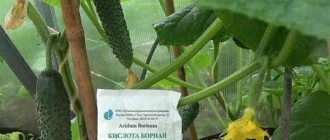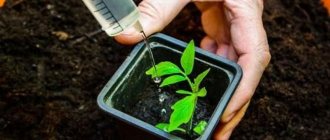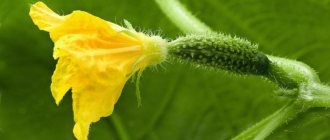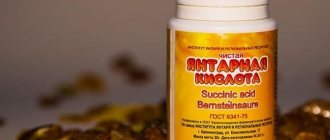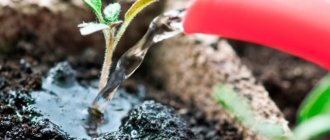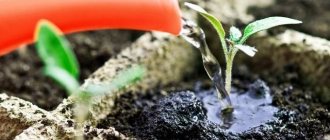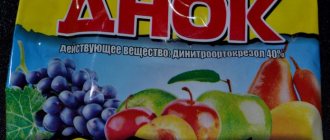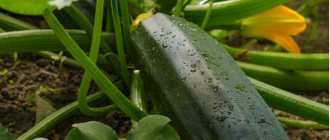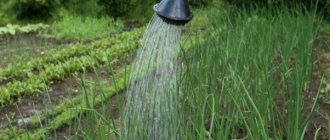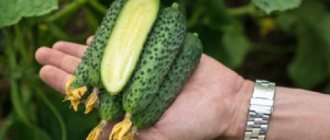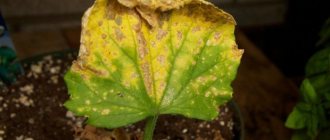What does iodine deficiency cause in plants?
Vegetable growers feed the crop with iodine due to its ability to absorb nitrogen. If the element is poorly absorbed, then the cucumbers will be weak and suffer from diseases.
Antiseptic is one of the components of protein. Thanks to it, oxygen enters the plant, which helps strengthen the immune system. Photosynthesis also occurs much faster if iodine is present in the green mass. Therefore, it is necessary to maintain its level in plants.
Element deficiency can be noticed in the following types of soil:
- sandy, sandy loam - useful microelements quickly penetrate into the lower layers of the soil;
- peat bogs – characterized by an increased level of acidity;
- podzolic;
- poor in organic components - the acidity level is also low.
Attention!
Iodine deficiency is rare in black soils and areas near the sea. It is necessary to add milk solutions with iodine in autumn and spring.
How to prepare whey for spraying tomatoes
Solution for spraying tomatoes: photo
After you have placed the milk with a heat source and it has turned sour, you need to warm it up a little before pouring it into the pan. Heating should only occur over low heat so that it does not boil over.
Little by little the milk will separate and the liquid that separates will have to be used and the rest discarded. From 1000 milliliters of milk, 500-550 milliliters of whey can be obtained.
To prepare the solution that will be used for spraying, you need to mix serum and water in a ratio of 30% and 70%. For a better effect against a fungal disease, you can add a small amount of grated laundry soap.
Soap helps to adhere to the surface of the plant. That is, thanks to it, the solution seems to stick to the leaf or shoot and lasts much longer than without adding laundry soap.
To increase the effectiveness of the solution, add a little iodine to it. Since it has a disinfecting effect.
Why does iodine need to be diluted with milk?
Spraying cucumbers with milk and iodine is a popular method. But using an antiseptic in its pure form can burn plants, so it must be dissolved in milk. The drink makes the effect of iodine softer and has the following properties:
- contains large quantities of microelements that benefit vegetables;
- milk contains lactose, which kills pathogenic microorganisms and fungi due to its intolerance;
- the fats on the leaves form a protective film that prevents the entry of microbes.
It can be used for watering and spraying.
Benefits of milk for plants
Milk is effectively used for feeding and health promotion for tomatoes. Its benefits are undeniable at all stages of cultivation:
- contains growth activators, valuable amino acids;
- it contains the most necessary macro- and microelements, such as iron, potassium, calcium;
- Thanks to lactose, it suppresses harmful insects;
- forms a protective film against pathogens on shoots and leaves;
- improves the quality of the compost composition;
- stimulates metabolic processes.
Tomatoes that are grown using milk have the best marketability, taste, and compositional indicators.
Like children, milk is useful for young bushes to grow. It contains many nutrients, vitamins, amino acids.
The effectiveness of a mixture of milk and iodine for cucumbers
The use of a solution of milk with iodine helps to overcome diseases and restore cucumber shoots. The effectiveness of this product is proven by reviews, but there are still certain precautions. For example, it is necessary to apply fertilizer in compliance with all proportions. If you neglect this rule, you can damage the cucumbers.
Useful properties of milk
Using milk for cucumbers helps nourish the plant:
- potassium;
- calcium;
- magnesium;
- iron;
- gray;
- phosphorus.
Attention!
You cannot spray cucumbers with full-fat, sterilized or pasteurized milk.
Thanks to the drink, plant development and flower formation improves. Milk is an organic product that has a beneficial effect on root development and extends the shelf life of cucumbers. It is allowed to fertilize the vegetable with kefir and yogurt.
Useful properties of iodine
Iodine is an antiseptic that can be used to get rid of late blight, verdigris, and rot. It will also help disinfect seed material before planting.
Feeding cucumbers with iodine has its advantages:
- restoration of damaged shoots;
- cucumber growth accelerates;
- increased fruiting;
- the taste of the product improves;
- new ovaries are formed;
- root nutrition.
It is necessary to treat cucumbers with milk with iodine, as it helps get rid of the fungus and nourish the plant with nutritional components.
Importance of iodine for tomatoes
By itself, an element such as iodine for tomato seedlings does not play any role for growth and development. If it is missing or not there at all, the plant will not notice it. So why is it necessary? The element has a stimulating effect because it improves the absorption and assimilation of nutrients and helps to activate the plant’s defenses in the fight against diseases.
There are several ways to supply iodine to vegetable crops. Plants receive it from the ground or with applied fertilizers - root or foliar treatments. It should be borne in mind that most often the presence or absence of this element is unknown, since it is not specifically added.
If we consider soils depending on the level of saturation with this element, we can distinguish between rich and poor soils. The rich include:
- peat tundra;
- red soils and black soils;
- chestnut soils.
The poor are as follows:
- gray soils and forest soils;
- podzolic;
- salt licks;
- brown soils.
Before artificially saturating plants with fertilizer, you should take into account the soil in which they grow and the fertilizers applied. Iodine-containing materials are: manure, peat, peat and wood ash, phosphate rock. If there is suitable soil or fertilizing, spraying tomatoes with milk with iodine is carried out only if problems arise that may indicate the need for action.
These are:
- a decrease in the usual level of yield or a significant decrease in the size of the fruit while maintaining normal care;
- late fruiting;
- low immunity of seedlings: their poor growth, disease, death;
- the appearance of fungal diseases;
- manifestation of iodine deficiency: weak thin stems, pale leaves.
A fertilizer for tomatoes such as fertilizing with iodine will help solve the difficulties that have arisen.
The effect of iodine on seedlings
Most often, the element is used as a good assistant only for tomato seedlings before the ovaries appear - its application later is not recommended. During this period, it helps the vegetable crop gain nutrients. This substance in itself is not a nutritional supplement. This is a powerful antiseptic, the use of which helps to cope with rot, fungal diseases, and disinfect seeds. Prevention of viral diseases is of particular importance.
See also
Characteristics and description of the tomato variety Raspberry RhapsodyRead
Treatment of cucumbers against diseases
To provide the vegetable with protection from diseases, gardeners water and spray it. Fungal infections are more common in mid-summer, so it is necessary to combat them during this period.
Watering
Cucumbers often suffer from root rot, so you should not apply fertilizer at the root. You need to dig a shallow trench at a distance of 10-15 centimeters from the stem to water the cucumbers with milk and iodine. The soil near the plant can also be sprayed.
Attention!
Vegetables growing in a greenhouse are watered after the soil dries. During the procedure, the greenhouse should be ventilated immediately.
Root feeding recipes:
- Mix a liter of low-fat milk and a bucket of water. Water with the resulting product at the rate of 500 ml per bush. It is possible to water the leaves through a watering can;
- You can increase the yield if you feed cucumbers with an acidic solution with nettles. To prepare, mix 500 g of fresh chopped herbs, 5 liters of water, 3 liters of kefir or curdled milk, and leave to ferment for 2 weeks. Dilute the concentrated mixture with liquid in a ratio of 1:10 and use for watering;
- During the growing season, water the crop with honey tincture: mix 2 liters of milk, 5 tbsp. honey, a glass of wood ash, 10 drops of iodine. Leave the resulting mixture for 48 hours before use.
Fertilizer is used during the formation of ovaries to obtain a rich harvest. To do this, mix 1 glass of sugar in three liters of kefir.
Spraying
Owners of garden plots often use foliar feeding for preventive purposes. For this:
- stir 20-30 drops of antiseptic in a bucket of water;
- add 1 liter of low-fat milk or 500 ml of whey;
- leave for 24 hours.
Spray at the rate of 1 liter per 1 square meter.
This mixture can destroy diseases and cope with aphid infestations. Its use will protect the crop and saturate it with essential microelements.
To combat dangerous infectious diseases, you need to spray 2 times a week until the signs of damage are completely eliminated.
Watering with milk solution
Nail fungus will go away quickly! Generously lubricate it with new ointment with kukui extract... Read more »
If you want to mainly feed the cucumbers, dilute 1 liter of low-fat milk in 5 liters of water, stir thoroughly and water the cucumber bushes with the resulting solution so that each plant gets about 0.5 liters of the milk solution.
It is better to dig a shallow groove around the entire circumference 10-15 cm from the base of the bush, so that the root is in the center of this circle, and water directly into this depression. Usually, the roots of cucumbers are located close to the surface and are able to find all the substances they need on their own.
By the way, you can water cucumber plants from above, this way the milk solution will be absorbed by the leaves and additional protection from diseases and pests will be provided.
Feeding cucumbers
Root feeding of cucumbers with milk with iodine differs from foliar feeding, since in the first case the solution is a fertilizer of natural origin. It improves the taste of the vegetable, saturates it with vitamin C. Prepare it like this: dissolve 4 glasses of low-fat milk in a bucket of water and add 15 drops of iodine. In this way, treatment can be carried out to prevent fungus and strengthen the plants.
Attention!
The constant use of such a product will replace chemicals.
Water the cucumbers with the milk mixture when planting the crop in open ground and repeat the procedure at the beginning of fruiting. After this, you can feed in this way constantly, but not more than once every 3-4 days.
You may be interested in:
How to feed cucumbers in a greenhouse with folk remedies Often, the yield of cucumbers is significantly reduced if the fruits are not provided with a sufficient amount of nutrients...Read more...
Implementation of treatment and preventive actions
Cucumber late blight is treated with iodine, diluted together with brilliant green in a ratio of 20:20 in a bucket of warm water. Seedlings should be sprayed every 10 days. Root rot is destroyed the moment the buds appear. The contents include up to 10 iodine drops per 10 liters of liquid.
If the leaves turn yellow, they are lubricated along with the stems with a solution of antiseptic and water in a ratio of 1:2 every day, reaching a height of 15 cm above the ground.
To get rid of powdery mildew, you will need 30 drops of the active substance diluted in a bucket of liquid + 1 liter serum + grated household soap.
Recipes for preparing the solution
Feeding should be regular so that the plants do not get sick and develop well. The antiseptic cannot be used independently, so solutions are prepared based on it. To get the desired result, you must maintain the proportions and apply fertilizers to the soil according to all the rules.
With milk, iodine and soap
Cucumbers should not be fed with pure milk. To increase its effectiveness, it is also necessary to add iodine and soap. Thanks to this method, it is possible to nourish the culture with important substances.
Attention!
Foliar feeding should be done a few days after emergence. Water the plant only after applying fertilizer.
To prepare it, dissolve 3 drops of iodine and grated laundry soap in a liter of milk. Mix the solution well before use.
With curdled milk
You can also fertilize cucumbers with fermented milk product. This type of feeding can only be used for adult plants at the fruiting stage. It delivers useful elements to the roots, destroys parasites, normalizes the acid balance of the soil and retains moisture in it.
To prepare the solution, you will need yogurt (5 l) and iodine (15 drops). Mix the ingredients thoroughly and pour the vegetable under the root. Apply the mixture 2-3 times a week.
You may be interested in:
Fighting spider mites in a greenhouse on cucumbers If you are interested in the question of how to get rid of spider mites on cucumbers in a greenhouse, you should familiarize yourself with folk...Read more...
With serum
Against aphids, gardeners often use fertilizer prepared from iodine (2 drops) and whey (1000 ml). Spraying with this mixture should be carried out once every 5 days. If there is no antiseptic, you can add brilliant green or ammonia to the mixture.
After spraying, in the first few days a white coating may appear on the leaves, there is nothing terrible about that. After watering it will wash off.
Why spray flowering tomatoes?
It is believed that spraying garden plants is most often carried out in order to protect them from attacks by pests and diseases. But during the flowering and ovary period, tomatoes most of all need mineral and organic substances. It is foliar feeding that can provide them. This treatment is a kind of first aid for plants. Indeed, in this case, the nutrients immediately, passing through the leaf shell, begin to work. And there is no need to wait until they dissolve in the soil and reach their destination through the root system. Timely and regular foliar application of both complex inorganic and organic fertilizers will help bushes that have gained color to quickly form an ovary and provide the necessary resources for the subsequent development of fruits. In addition, sometimes when there is an excess or deficiency of certain elements in the soil, tomatoes need targeted help.
The result of foliar feeding will be noticeable within a few hours
How to understand what exactly they are missing? To answer this question, it is often enough to take a closer look at the tomato beds.
- If your plants stretch before your eyes, characterized by spreading bushes, which, unfortunately, have almost no flowers or ovaries, we can assume that this is a consequence of excess nitrogen in the soil. The application of phosphorus and potassium fertilizers will help correct this deviation.
- A lack of phosphorus can be signaled by a purple tint to tomato leaves.
- Small shoots on plants indicate a lack of copper and sulfur.
- If the leaves bend down and the top of the bush curls, a zinc deficiency may be suspected.
- Pale green leaves of young plants curled down and black spots may indicate boron deficiency.
- Tomato leaves that lack iron begin to droop and turn yellow at the ends.
Spraying correctly
Despite the fact that spraying tomatoes is a seemingly elementary procedure, it also requires compliance with certain rules. First of all, you need to listen to the weather forecasters. A cloudy, cool day is suitable for spraying. Rain in this case will be unnecessary, since it will simply wash away all the fertilizers. Foliar feeding is carried out in the evening, when evaporation is minimal. Each plant is sprayed generously, moistening the leaves both above and below.
Rules for spraying cucumbers with milk with iodine
To get the desired result, the treatment of cucumbers with iodine and milk must be carried out strictly according to the instructions and following the following rules:
- treat crop shoots and plants on both sides;
- Before fertilizing, moisten the soil;
- if there was precipitation or dew the morning after the procedure, then repeat the procedure;
- feed cucumbers with an antiseptic and a dairy product on a cloudy day in the morning or evening;
- You should not combine fertilizing with iodine and milk with other types of fertilizer;
- use of the solution is allowed weekly;
- strictly follow the dosage, since an excess of iodine can burn the leaves;
- The prepared mixture cannot be stored.
If you adhere to these rules, the likelihood of crop damage is reduced.
Attention!
If full-fat milk is used for fertilizer, it is diluted with water.
When processing cucumbers in a greenhouse, you can also use these rules.
How to fight late blight?
What is late blight? This is a common fungal disease that is quite popular among gardeners and gardeners. The spread of the disease occurs through spores. The disease can be recognized if the plant is carefully examined.
If there are black fruits, leaves that have begun to turn brown and dry out, as well as dark spots behind the leaves, we can conclude that the plant has been infected with late blight.
This disease is considered very severe. Therefore, with large-scale distribution, tomatoes are very difficult to cure, and sometimes almost impossible.
With partial infection, the chance of saving the plant increases. To do this, you first need to remove infected leaves, shoots and stems. All these parts must be burned.
Infection could occur due to excess moisture introduced or due to high air humidity. Late blight can often occur in closed ground if the greenhouse has not been ventilated. Weak tomatoes that lack nutrients have low disease resistance and therefore cannot resist late blight.
You can fight this disease using different methods. But the basis of all methods is the disinfection of the plant and the entire environment in which it is located. This is exactly the task that a solution of iodine with milk performs well.
At the initial or medium stage of spread, treatment can be carried out every day. Only at a high stage of spread, the bush cannot be saved and should be disposed of.
Note: Late blight spreads very quickly. Therefore, you cannot delay treatment, otherwise the bush will die completely and it will spread to other bushes.
Treatment with the solution should be carried out every day. Since the solution may be washed off or the effect of the solution may expire. And with daily spraying, the solution constantly acts and actively fights late blight.
Late blight dies due to the fact that milk and whey have an acidic environment, which is fatal to the disease.
Processing times
Vegetable growers use iodine-lactic fertilizer at each stage of cucumber development, since it is natural. Timing when gardeners process crops:
- The solution can be used to prevent the appearance of parasites and diseases as soon as 4 true leaves appear on the seedlings. Repeat the treatment every 14 days;
- In order for the vegetable to develop fully, it needs to be fertilized 10 years after planting the seedlings or after the first shoots appear. It is allowed to use a milk-iodine mixture at the beginning of the growing season and during the formation of ovaries;
- at the stage of active fruiting, treatment is necessary for a rich harvest.
Attention!
After the first spraying, the fertilizer must be reapplied at the root.
In spring, you can water the soil with liquid before sowing. Cucumbers growing in a greenhouse begin to be processed after two true leaves appear.
Precautionary measures
Milk does not have toxic properties, but the antiseptic can severely burn if it gets on exposed areas of the body. Therefore it is necessary:
- carry out the procedure in protective clothing;
- Maintain the correct proportions and dilute the products strictly according to the instructions;
- use a spray bottle for spraying;
- fertilize in cloudy, windless weather;
- Do not store the mixture for a long time.
If the solution enters the body, you need to drink a lot of water and seek help.
Prevention
Reviews from gardeners prove that a solution of milk and iodine is an effective means for preventing the development of diseases. Thanks to timely processing, the appearance of rot and fungus can be prevented.
To do this, you need to mix 50 g of urea and 20 g of iodine in two liters of whey. Water the crop with this product at least two and no more than three times per season. Prevention should be carried out after the appearance of 5 leaves. Repeat the procedure after 14 days. In this case, disease outbreaks can be avoided.
Attention!
The product is suitable not only for cucumbers, but also for peppers, cabbage, tomatoes, zucchini, and blueberries.
Fertilizing does not pose a danger to plants, provided that all proportions are strictly observed.
How to use for tomatoes
Boron chemical compounds can be found in several drugs available over the counter in pharmacies and agricultural stores. All of them are effective and inexpensive, but depending on the form of release and the presence of additional compounds, they can be used in different ways.
What boron preparations are there:
- Boric acid. The most optimal product for use in the garden. Most often it is diluted in a solution for spraying plants.
- Boric superphosphate. It is a professional fertilizer and is sold in agricultural stores. It is used no more than three times per season as the main fertilizer when there is a sufficiently strong lack of boron in the soil.
- Borax. According to its chemical composition, it is a salt of boric acid. It is also most often used as a root feeding.
- Special fertilizer “boron - magnesium”. In addition to boric acid, the composition also contains magnesium oxide. The slightly inconvenient release form makes it difficult to use. Used for complex plant nutrition.
You may also be interested in information about what a determinate tomato variety means.
Video on how to use boric acid for tomatoes:
In addition, boron compounds can be found in complex fertilizers. Despite the relative rarity of such an element, without it it will be difficult to achieve good results. That is why many gardeners practice using homemade fertilizer recipes containing two available preparations: iodine solution and boric acid. But what ultra-ripe varieties of tomatoes exist for open ground, and how to choose the right variety is indicated here.
When wondering how to dilute boric acid, the answer will be the best folk recipes for feeding tomatoes with boric acid and/or iodine:
- The following mixture is used for spraying. In a liter of water, you need to dissolve a glass of low-fat milk and add five drops of iodine. Spraying should be carried out with as small a fraction of droplets as possible. This treatment helps strengthen plant immunity and is often used in greenhouse cultivation to prevent disease outbreaks. This treatment can be used no more than three times per season.
- Most often, boric acid is used for pre-treatment of seedlings or seeds before planting in the ground. The following proportions are observed: 0.2 ml of boric acid is used per liter of warm water. Seeds need to be soaked for about two days, grown seedlings - from 12 to 24 hours. But what are the best tomatoes for open ground, which are very well affected by boric acid, are indicated here.
- Foliar treatment with a nutrient solution is used to improve the taste of the fruit. For this, a standard dosage is used: per bucket of water (10 liters) 10 ml of boric acid and three drops of iodine. This treatment can also be carried out no more than three times per season. But what are the earliest varieties of tomatoes for open ground, and how to feed them correctly, this information will help you understand.
- Root application of boric acid is carried out extremely rarely, because this element can cause burns to the roots. It is best to use a nutrient spray solution, which consists of three liters of water, three drops of iodine and five drops of boric acid. This treatment is carried out three times per season.
- If there is a need to cultivate the soil, the procedure must be performed after collecting all the fruits during the autumn digging of the soil. It should be noted that even with a severe deficiency of boron in the soil, such treatments are carried out no more than once every three years. The concentration of boric acid increases and is about 10 ml per three liters of water. The substance dissolves only in a warm environment, so use warm, almost hot water (additional treatment against pests and fungus).
Folk tricks for growing garden crops offer many ways to achieve high yields without the use of purchased chemical arsenal.
You may also be interested in information about what are the most productive tomatoes for open ground.
The features of using boric acid and iodine in your garden are discussed in the information in this article.
Reviews
Vladimir, Moscow region.
Relatives have been using a solution of iodine and milk for several years to process cucumbers in order to get a rich harvest. I always thought it was a waste of time, but I decided to give it a try. For 5 years now I have been using a milk-iodine mixture to feed vegetables. Apply several times a week and the fruits grow not only tasty, but also without nitrates.
Konstantin, Omsk
My acquaintance with the mixture began to quickly get rid of aphids. I deeply doubted that there would be any use, but there are no more harmful insects on my site.
In order for the use of fertilizing from milk with iodine to be effective and not harm the cucumbers, it is necessary to strictly follow the instructions, observe the dosage and follow the recommendations of agronomists.
How to use the product
Iodine fertilizing is applied during root watering or foliar spraying. It is most effective to alternate methods of using the drug, while the tomatoes will receive both nutrition and protection from pathogenic microorganisms.
Root application
It is very important to strictly adhere to the dosage of the drug. Excess iodine can negatively affect plants: cause burn spots on leaves, lead to deformation of fruits, and significantly impair taste.
Root dressing is applied to moist soil
Table: root feeding of tomatoes with iodine
| Time | Preparation of the solution | Drug consumption |
| There are 2–3 true leaves in the phase. | 1 drop\3 liters of water. | 50 ml/plant. |
| 10 days after planting the seedlings in the greenhouse. | 3 drops\10 l. | 500 ml\bush. |
| Before flowering. | 3 drops\10 l. | 0.7–1 l\bush. |
| During the fruiting period. | Pour 250 g of ash with boiling water (5 l), cool, bring the volume to 10 l, add 5 ml of iodine and 10 g of boric acid. Leave for 24 hours, dilute with water 1:10. | 1 l\bush. |
Iodine and ash are a complex fertilizer with protective properties that saturate tomatoes with essential substances and protect against pathogens
Video: the best fertilizer for tomatoes
Foliar treatment
Spraying leaves with iodine solution is used to treat tomatoes for the purpose of prevention and to combat emerging diseases. This foliar feeding allows not only to protect against fungal diseases, but also to accelerate the ripening of the crop.
Iodine for spraying tomatoes in a greenhouse can be used once every 2 weeks
Iodine with greenery
To prevent late blight or at the first signs of damage, use a solution prepared from iodine (5 drops) and brilliant green (20 drops) per 5 liters of water. Using a sprayer, the liquid is applied evenly from bottom to top. Preventive spraying is carried out 10–12 days after planting seedlings every 2 weeks. If tomatoes are not developing well, you can add 1-2 drops of Zircon, a growth regulator.
Iodine and brilliant green are effective antiseptics
Video: iodine + brilliant green against late blight and tomato diseases
Iodine with milk
A milk solution of iodine is also an effective protective agent against diseases. 1 liter of warm water is mixed with 5 drops of iodine and 200 ml of low-fat milk. Preventive treatment is carried out once every 14 days.
A solution of milk with iodine will help save the tomato crop from diseases
Iodine kills pathogenic bacteria, and lactose covers the plants with a durable film, preventing fungal spores from penetrating them. After spraying with iodine milk, tomatoes begin to grow intensively, bloom profusely and set fruit. To combat late blight, you can prepare a more effective composition of 9 liters of water, 40 drops of iodine, 1 liter of whey and 1 tbsp. l. hydrogen peroxide.
Spraying tomatoes in a greenhouse with a solution of iodine and milk allows you to grow healthy plants and get a good harvest
To create a healthy microclimate for tomatoes, I hang tea bags soaked in iodine (one bag per m2) in the greenhouse. Iodine vapor, spreading throughout the greenhouse, kills fungal spores.
Tea bags soaked in iodine can be used to disinfect greenhouses with tomatoes
